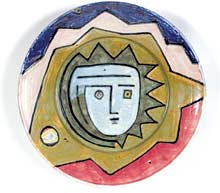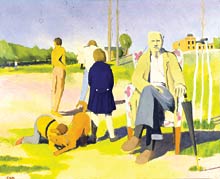If you like art museums with gimmicky or trendy exhibitions, this is not a good time to go to the Fine Arts Museum at Western Carolina University. There are three exhibitions on display, and all offer serious examples of artistic achievement.

The main gallery houses ceramics from Norm Schulman: A Life in Clay, a retrospective of the North Carolina ceramic artist’s work. It’s accompanied by complementary abstract paintings by Kenneth Noland, Quita Brodhead and Louis Finkelstein. One of the adjoining galleries contains selections from Schulman’s personal collection. It is clear that this is an artist who has no fear of experimentation, and who respects and admires quality work by other artists no matter what the style.
Another of the smaller galleries holds a lovely selection of prints, drawings and paintings from the museum’s permanent collection. There is a moody, confidant charcoal landscape by Martha Armstrong and a small, almost flamboyant oil painting by Lois Dodd called “Apple Tree.” Paul Russotto’s small semi-abstract etching is filled with movement and mystery, while the larger undated and untitled abstract painting by Mary Parker is straightforwardly joyful.

A few years ago, the Spanish government built a museum to house the works of Esteban Vicente, even though the artist spent most of his life in the United States. His print in the WCU collection is strong in color and in composition. A number of Black Mountain College alumni remember Vicente as an influential teacher.
Figuration in the exhibition runs the gamut. Study for a portrait of “Linda” by Thomas Trosch is decidedly postmodern, while the flat, patterned, pastel-colored painting by Edith Neff, dated 1964, harkens back to another movement entirely, with a feeling of separation and pathos in the work.
A small opulent gouache by Rosemarie Beck and an engaging watercolor by Chuck Bowdish present interesting narratives, one somewhat familiar, the other open-ended. Gwendolyn Knight Lawrence’s etching evokes all the power found in Rosa Bonheur’s rearing and prancing animals. Remarkably, these works, diverse as they are, are presented in such a way that they hang together in a harmonious whole.
The third of the contiguous galleries is filled with works from the Tri-State Sculptors’ exhibition, which in many ways lives up to its title: MicroMonumentals. The sculptures are small, but some of the concepts are indeed monumental.
Prize for the scariest piece has to go to Mark E. Brown for “Peep,” in which black skull sits atop a faceted orb held up by cast bird legs. One claw grasps a black egg. The most elegant of the works is one in bronze and stone by Deborah LaGrasse. In another nod to the state of the natural world, Jim Wheeler presents a bronze work in the shape of an open pod, called “Metamorphosis.”
Some pieces, like Michael Warrick’s glass boat and his bronze house, are quiet and contemplative. Other works, like Cristin Millett’s “Undulation of the Pubococcygens” and Robert M. Bickey’s “The Childish Hand of God 6fs,” are complex and created from high-tech materials. Irony finds its way into the show with David Newton’s pieces and Jon Rajkovich’s mixed-media works, all subtitled “Dog Toy.” Marya Roland’s “ME3,” a three-sided soft sculpture featuring distorted photographs of her face, is open to dozens of interpretations, personal or mythical.
Greg Shelnutt’s trio of small cuckoo-clock shapes made of lightly sanded, weathered wood is titled “Bottle Cap Apostles: St. Peter,” “St. Judas Iscariot” and “St. Andrew.” Each is adorned with a symbolic artifact.
Meanwhile, Paul Van Zandt’s “Divergence” is a beautifully crafted work, that of a dark-stained wood carving of the head of a Native American brave which lies horizontally on a shallow base. A minute plastic figure of an Indian shooting a rifle straddles his head at the top, and standing on the base below the chin is a big-bellied white man in a fancy suit.
It could be that the work in the exhibition with the greatest impact is “Bound” by Rae Goodwin. A sterling silver baby spoon is obsessively wrapped and wrapped in wine-colored cotton thread.
[Connie Bostic is an Asheville-based painter and writer.]
Norm Schulman: A Life in Clay and the Tri-State Sculptors: MicroMonumentals
what: Two gallery shows
where: Fine Arts Museum at Western Carolina University
when: Both on display through Saturday, Oct. 6. (Free. www.wcu.edu/fapac or 227-2479)



Before you comment
The comments section is here to provide a platform for civil dialogue on the issues we face together as a local community. Xpress is committed to offering this platform for all voices, but when the tone of the discussion gets nasty or strays off topic, we believe many people choose not to participate. Xpress editors are determined to moderate comments to ensure a constructive interchange is maintained. All comments judged not to be in keeping with the spirit of civil discourse will be removed and repeat violators will be banned. See here for our terms of service. Thank you for being part of this effort to promote respectful discussion.